Author's Note: This was originally posted on my old blog on June 25th, 2020.
20/07/2024
Who's to Blame for The Legend of the Crystal Lens?
Early last year a friend was culling their collection of books and offered to let me and my partner pick over it for anything we wanted. Thoroughly addicted to the dopamine rush of acquiring new books we eagerly took them up on the offer, digging through the pile of stories they hadn’t touched in years. There was a decent selection of trash in there, the kind of stuff you loved in high school and cringe at later once you’ve developed taste. Always suckers for “So bad it’s good!” we gleefully scooped up a couple of them.
This is how I came to own a copy of The Legend of the Crystal Lens, by Samantha Graves.

Cover
A quick aside, I should note that this book is normally known as Out of Time, and that I apparently have the British printing that goes by a different title. I can’t express how much the non-existence of this book online confused me until I figured out what was up. I’m going to stick to the British title throughout this just for clarity’s sake. I find changing the name after the fact rather confusing, and I just know I’ll slip back and forth constantly otherwise. I’ll also note that Samantha Graves is a pen name for C.J. Barry, a fact we’ll be coming back to later.
The Legend of the Crystal Lens is the author’s second book under this pen name and her seventh overall. A romance story, it centres around the two leads of Jillian Talbot and Simon Bonner. Here’s the blurb:
Simon Bonner, bad-boy tomb raider, wants out of the looting game ... until a mysterious crystal lens lands on his doorstep. Legend has it that this lens holds the key to the archives of man - a tomb that explains the root of all knowledge. There's just one problem - he hasn't a clue how to use it. Museum curator Jillian Talbot's ability to see an object's history is her secret, so when Simon approaches her she can't quite believe that she's the 'one', the seer of legend who can unlock the mystery behind the crystal lens. Journeying into the perilous jungles of Mexico, with thieves hot on their tail, every second proves precious for Jillian and Simon, and every move a terrifying dance with danger.
That blurb makes the book sound a lot more interesting than it is, in reality it’s very bad. I wanted to start with something I really liked about it before the griping begins, some small thing that helped me get through. The closest I have is imagining what some of the interesting ideas might have been like if they hadn’t had their potential squandered. No good decisions were made at any point in the writing of this book, so we might as well get started on its problems.
For this to make any sense however I’m going to have to give a quick synopsis of the plot.

The story starts when Simon Bonner gets the titular lens from his ex-wife Celina’s new husband, who passes on the information his wife’s kidnappers have given him: find museum curator Jillian Talbot and use her and the lens to find a great treasure. He is then promptly killed by ruthless hitman Kesel, who has a history with Simon.
Now on the run Simon manages to rescue Jillian from Kesel’s associates and then kidnaps her himself, taking her to his archaeological artifact expert and surrogate father figure Yancy. It is decided that they need to visit Mancuso, a friend in Mexico, to get more information on what they’re looking for and where. They head off, but not before Paulie, an employee of Jillian’s badass tomb raider sister Raven shows up to tag along as their hacker. In Mexico the trio meet Mancuso, and Simon’s old acquaintance Alexis says hello before immediately selling them to Kesel. The leading couple then heads off alone to search Olmec ruins with Kesel tailing them. The kidnappers also follow at a more sedate pace, and it is revealed to the audience that Celina is the kidnapper.
Simon and Jillian meet with Lance, Jillian’s ex, and he assures her he didn’t tell anyone about her secret power to see the past. He is lying, actually being Celina’s lackey. Things progress and we end up in the mountains, with the leading couple in front, followed by Celina and Lance, then Kesel and his sidekick Carlos, and then Donovan, a guy Celina has hired to kill everyone. Celina takes Jillian into the ancient temple where the treasure is, Simon escapes Lance and follows, with Kesel behind him. Donovan arrives last and sets up to wait for whoever comes out alive. Traps and gunfights happen, and Jillian collapses the temple to keep it from falling into the wrong hands. Only Jillian, Simon, and Celina get out alive. Donovan then reveals he is actually working for the Mexican government and arrests Celina for her smuggling crimes and the lead couple smooch on a beach. The end.
Now that everyone has a basic understanding of the story we can begin.
Let’s start by talking about that wasted potential. Seeing the history of things is a neat idea, one that would be useful for say, an archaeological badass. Plunging into ruins and discerning the identity and purpose of things in mere moments, and with more accuracy than others could with years of research. Why isn’t the book about that?
Well it turns out it’s because she already wrote that story, it’s called Sight Unseen and it’s about Jillian’s sister Raven, who steals back already stolen art. That’s neat, but it begs the question of why this novel exists then. Why did she create the same character but less interesting? Raven is a Lara Croft style action hero, Jillian is a helpless damsel. Raven has agency, Jillian is a plot device. Jillian exists to point the way to the treasure and to swoon over the male lead, and that is it. Never does it feel like this woman and her psychic powers are anything more than a treasure map. Every single other character (with the exception of the villain’s pushover lackey) has agency, they seek things out and make things happen. Jillian sits around waiting for things to happen to her, the perfect little damsel. A complete waste of what could have been an interesting character with an interesting ability. Her far more interesting sister is mentioned by the way, but never makes an appearance beyond being referenced a few times, which is a shame.
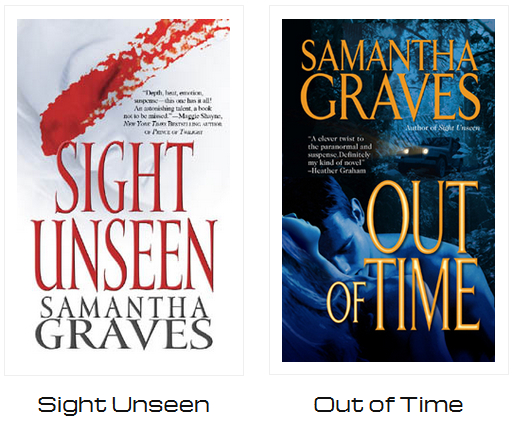
A concept so nice she wrote it twice.
The next problem is the laziness and shocking lack of research on the author’s part. The most obvious is in the complete lack of any sort of interesting Mexican cuisine.
Here’s our first meal in Mexico:
At midnight, Simon was nicely relaxed by a few margaritas, a couple of laughs, and some good Mexican food, and he was just getting into bed when Jackson’s cell phone rang.
Just “Mexican food”, couldn’t even swing by Wikipedia to pick something off a list. Other than this we get tortillas a couple of times and then finally some flautas make an appearance after more than a hundred pages of being in Mexico. I did the quickest of searches for “Catemaco cuisine” and immediately found this:
Carne de chango (Spanish for "monkey meat") is a lime-marinated, smoke-cured cut of pork loin principally seen in the Catemaco region of the state of Veracruz in Mexico. The switch from monkey meat to pork meat arose from the hunting to the edge of extinction of the two monkey species resident in the Sierra de Los Tuxtlas. -Wikipedia
Swap out the flauta for some carne de chango and now you have a dish that shows off a regional specialty. For an author who loves exoticism, she’s not very good at adding exotic foods, I suspect because she doesn’t know they exist.
There’s also laziness in the characters, with the mexican cast being composed entirely of stereotypes. From a moustached man who wears a straw fedora and smokes (Carlos), to a white suited man who wears a straw fedora and drinks margaritas constantly (Mancuso), we’ve got all the laziest character designs! Even the leads aren’t immune, Simon is hot because he’s bronzed and muscled, Jillian is hot because she’s skinny and pale. If the author can’t be bothered to spend more than five seconds thinking about any of these characters, why should we?
Now we get to the heart of the matter, this book is badly written. Some of the problems are more irritating than anything, for example this quote from superhacker whiz kid Paulie:
He handed her a wad of money. “I hit the ATM machine yesterday. You might need more cash.”
The kid whose sole purpose in the story is to be a technological genius, doesn’t know what ATM means. For anyone too embarrassed to ask, it stands for “automated teller machine”, adding machine on the end makes it “automated teller machine machine”. It makes you sound stupid to people who know better, and it’s a really weird mistake for a tech wizard to make.
Here’s a gem from the beginning of the book:
Jillian loved the Linden Museum at night, after all the guests had left and the small staff had shuffled out. By 8 p.m. on a Friday night, the place was empty and all hers.
…
Heavy footsteps wrenched her from her sadness, and she turned to find the museum’s night security guard approaching. “Hello, Charlie,” she said. “I didn’t think you were still here.”
Jillian Talbot, head curator of this very museum, doesn’t know that the whole point of night security is to be there at night. This chapter is her introduction, and it doesn’t paint a great picture of her mental acuity, or the author’s for that matter.
These are minor issues though, let’s now talk about the mystery, an important piece in this story. The story has all the mystery of one of those reality tv shows that preview what’s coming after the adverts.
The story starts with Simon and Jillian being harassed by at least two antagonists, Kesel and the kidnappers, neither of which they know the motivations of.
It’s a fine setup that is immediately ruined by every single antagonist laying out their plans in detail for the benefit of the audience. Kesel and Carlos, his fence buddy of many years, explain to each other their plans and motives like they’re presenting a powerpoint.

“Going into the next quarter we’ll be implementing a clumsy exposition strategy…”
This is a third of the way into the book, and it’s also when we get this line from Carlos:
“Yes. Yes, that’s good. But what if Celina beats us to them?”
This is Carlos casually unveiling the obvious twist that Celina faked the kidnapping and is in fact the mastermind. Then just over halfway through the book she and her spineless lackey (Lance) sit in a hotel explaining the entire situation and how it came to be. The only character who isn’t completely overexplained (and also the only one I actually like) is Kesel.
Any and all mystery is killed by hamfisted exposition, leaving us with nothing to think about. Everything has already been explained and there’s no reason to keep going. This is a romance novel after all, we already know Simon and Jillian will inexplicably end up together despite having no chemistry whatsoever.
Let’s touch on that too.
Simon Bonner is a bad boy, he gets in fights and does crimes. But he’s a good person anyway, he doesn’t do evil plans and he doesn’t kill people. What he’s actually been doing for the last decade or so we don’t know, we simply know that he’s jaded and cynical. This cynicism is largely due to his white savior escapades as a teen, where he led locals in raids on mexican tombs that could be easily looted in a single night by complete amateurs but had somehow not been touched in the hundreds of years they’d been there. Sure.
Jillian Talbot likes old stuff. She doesn’t know how to drive and she is easily scared. That’s her whole personality.
So when this man and this plot device meet they argue, they can’t stand each other and bicker constantly. This seems to be the author’s idea of chemistry. I personally consider it a bore to read and incredibly difficult to reconcile with her suddenly falling in love with this generically attractive man who she shares no interests with and starts off actively despising for kidnapping her.
In the beginning he is her kidnapper, and she hates him and is scared the mafia will leap out of an alley to murder her for some reason. Then she merely hates him because she loves history and old stuff and he couldn’t care less. Then she gets jealous of him interacting with another woman. Then she gets drunk and tries to make out with him because he has muscles and a tan. Then he scares her, then they argue in a museum because he doesn’t care about old stuff. This argument takes most of a chapter but it boils down to Jillian loving old stuff for the glimpses into the lives of past people (literally in her case) and Simon sees them as merely means to an end. A tool to be used, a piece to be sold, a prize to be bartered for his kidnapped ex.
Then the very next chapter he buys her an old necklace and she falls head over heels. Here’s the passage:
She opened her eyes when Simon removed her hat and lowered the necklace over her head. It settled perfectly between her breasts, exposed by the low tank top.
Her fingers traced the length of the crystal, feeling a strange warmth. It was the same feeling she got whenever she worked with an artifact with positive memories. In this case, a gift from Simon.
Something old.
Something from the past.
For her.
She inhaled at the insight. He knew.
When she looked up at Simon, his eyes were dark and intense. A shudder went through her at the concentration of his focus. Blood flowed to key parts of her body in dangerous anticipation. For the first time in her life, she felt truly understood by a man, Now she knew why her mother tried to save her father. Why a woman would risk that. But she couldn’t. It would hurt too much.
Ohhhhh boy. This right here is a point where I had to put the book down and go rant to my partner. It’s just so stupid. A few sentences back she hated him, but receiving a gift from him is enough to mark this object with a positive memory. And then she swoons at him knowing she likes old shit. Everyone knows you like old shit Jillian! It’s the only character trait you have! And then that night they have bad missionary sex. He doesn’t eat her out, there’s no foreplay, he just jams his dick in her and she comes from it. It’s the best sex of her life. It reads like it was written by a man with an eternally unsatisfied wife, which is especially crazy since A WOMAN WROTE THIS! It’s both infuriating and sad that a woman can hold up a sex scene from My Immortal as her greatest fantasy, which I promise we’ll dive deeper into soon.
Last on the list of “things Samantha Graves screwed up royally” is the handling of poverty and societal problems. Several times Jillian makes comments on how poor and sad the people of Mexico are, like this one:
She spotted a little girl watching her from the doorway of one of the shacks. Big brown eyes studied her quietly. Her hair was long and uneven. Her fingers were dirty, and Jillian almost gasped when she put them in her mouth to suck on.
She appeared to be about three years old, but her eyes were ancient, seeing far more than she should ever have to. There was no smile for Jillian. No reaction. Nothing.
…
She’d never seen such poverty. Manhattan had its poor, but nothing like this. Dirt poor, Simon had told her, and he was right. She probably had more money in her pocket than anyone in this town made in a whole year.
This was their everyday situation. Did the children go to school? Did they laugh? Did they realise there was more to this world than what they could see?
Jillian feels bad for a minute and then never thinks about it again. The author also never thinks about it outside of these isolated moments until suddenly Donovan, hired by Celina the mastermind to clean up when her plan is finished, reveals he is working for the Mexican government to stop people from stealing their stuff. This reveal happens in the very last chapter, with absolutely no buildup. The one piece of foreshadowing I could find is Celina’s lackey wondering how the cops intercepted their last deal with Donovan. It’s a shocking twist to come at the end of a book where the author tells you everything immediately.
It’s also a wonderful example of how poorly handled the topic is. Colonialism, international profiteering, and the harm this has on the people being profited from is a big heavy topic to tackle. The atrocities committed in the name of greed are innumerable and devastating, and they still happen to this day. If you’re going to make that an important part of your story, you had best do a damn good job, and Samatha Graves does not. The topic is given a few brief appearances, one of which establishes Simon as our beloved white savior, a character jumps up to champion it a few paragraphs from the end, and then the whole thing is shooed off stage so we can focus on the more important issue of whether two Americans are in love (Again, it’s a romance novel, we all know they are). Mancuso, the Mexican friend who owns a mansion and a private beach, isn’t even mentioned. You’d think the stark divide between his lifestyle of being a horny old man drinking endless margaritas and that of the half starved children living in tin shacks would be something you’d comment on, but apparently not. Mancuso is just a harmless old man, and we don’t need to consider the ethics of his lifestyle at all.
The whole thing reeks of a comfortably middle class white woman wanting to tell someone else’s story without even consulting them, and not realising the uncomfortable parallels this has to the exploitation she’s writing about.

The foremost authority on the plight of Mexicans, apparently.
That does it for things we can lay squarely at the feet of Samantha Graves and her editor. There’s still more problems to be exasperated by, but who’s to blame for them is less clear cut.
The Legend of the Crystal Lens is a book that subscribes to contemporary mainstream American beauty standards. Here’s our first proper description of Jillian:
...it was also damn near impossible to hide the blonde-haired, blue-eyed beauty, even in New York City. Tall, willowy, and dressed in designer clothes, she was hard to miss. He’d had no problem picking her out on the street.
Here’s Simon:
Simon was wearing long, loose flannel pants, but above that, nothing but beautiful bronzed skin and lean, rippled muscle. Wow.
…
Then Simon’s back muscles flexed, and she was distracted again. He snagged the cookie jar off the counter, and she tried not to stare at his chiseled torso when he straddled the stool across from her.
Wow! How incredibly imaginative! She’s tall, thin, blonde, and has full lips and pale white skin. He’s tall, buff, and has bronzed white skin. Together they’re exactly what society tells you to find attractive, and there’s surely no harm at all in reinforcing that incredibly narrow and nearly universally unattainable standard. This on it’s own would simply earn derision from me, but Samantha Graves isn’t happy with that, she has to keep going.
Every vendor greeted them with beautifully bronzed, smiling faces that carried the integrity of their Mayan ancestors.
What in all the hells is that supposed to mean?
This was fascinating, the way these people lived. Little had changed culturally for generations, and she didn’t want to miss a thing. She’d seen enough remnants of the past to appreciate the present.
Ahhh, here’s that exoticism Graves loves. Does anyone else find this kind of fetishistic?
We’ve previously established the author’s love for stereotypes, and now we see that she also goes in for the noble savage myth. Great! Mexico as a whole is presented as primitive but beautiful, poor but noble. I feel skeevy reading it. Once again the white woman who won’t do proper research rears her ugly head.
I realise I’m blaming the author again, so let me actually deliver on that wider question of guilt.
Samatha Graves appears to suffer from some internalised misogyny. There’s only four named female characters: Jillian, Raven, Alexis, and Celina.
Compare this to the nine (ignoring named but unimportant thugs) male characters that have meaningful impacts on the plot: Simon, Yancy, Mancuso, Paulie, Kesel, Carlos, Lance, Donovan, and to a lesser extent Walsh. Of the four female characters we get, Raven never makes an on screen appearance and largely serves as a way to get Paulie into the picture. That leaves us with three named female characters that mean anything, a three to one ratio.
Running the Bechdel-Wallace test over it real quick we find it fails. The only time two of our named characters speak one of them is holding a gun on the other, and it’s less a conversation and more barking orders with occasional responses. For the brief second it does slip into something resembling a conversation though it’s about Simon and how Celina never loved him.
This is because Celina is incapable of love, and cannot be loved herself. She falls onto the whore side of the Madonna-whore complex that is in play in this story. Celina is cruel, greedy, manipulative, and debased. Jillian on the other hand is a Madonna, beautiful and pure, and the object of Simon's desires. Jillian has one previous relationship we know of, Lance, and it comes across as utterly sexless.
Here’s our first interaction with Lance:
Simon picked Lance out immediately. Wearing expensive sunglasses, an L.L.Bean golf shirt, and starched plants, he sat alone at a table facing the park, sipping a margarita. He smiled when he saw Jillian approach and stood up to greet her.
Jesus, he looked like he’d just stepped out of GQ. His jaw was perfectly square, his hair cut just right, his teeth straight and white.
Simon hated him instantly.
He hung back when Simon pulled his sunglasses off and hugged her. Jillian stiffened and broke it off before Lance could give her a kiss, and Simon felt a perverse smugness. They exchanged a few pleasantries before Jillian introduced him. “And this is Simon”.
To his growing satisfaction Lance looked positively confused as he shook Simon’s hand. The handshake was smooth and light. Not the kind of hands that dug in the dirt for artifacts. Also not the kind of hands that could snap a man’s neck.
Lance is immediately established as effeminate. He’s soft and pretty and weak. He is the complete opposite of what toxic masculinity would consider a real man, and to make matters worse he’s ruled by a woman. Every time the two of them are together we are reminded that Celina is in charge, and Lance is only a tool. Every aspect of the way he is written instructs us to despise Lance. Jillian doesn’t want any affection from him, and there is not a hint of chemistry.
Compare and contrast with Simon. Simon is strong, attractive in a rugged outdoorsman way, and on the previous page he calmly disposed of the body Kesel planted in their jeep. Simon is a REAL MAN who does MANLY THINGS. He’s the action hero, dangerous and sexy, while Lance is a Ken doll, pretty but utterly sexless.
Alexis is our final entrant in this objectification pageant and another whore, this time literally. Alexis makes her money acquiring and then selling information to the highest bidder, and doesn’t mind using sex as a tool. She also loves sex for its own sake. Here’s some different passages on Alexis:
His eyes were glued to the woman with the clingy blue dress, long powerful legs and dark cascading hair. In fact, she looked a lot like Raven. Capable. Powerful. Confident.
Alexis was a woman with an insatiable appetite and amazing stamina.
Her perfume wafted over him as she leaned close. He noticed new fine wrinkles around her eyes when she smiled.
“Let me guess,” Simon told him. “Long legs, thick black hair, enough perfume to create her own smog, and built for speed.”
She made a long humming sound. “Is that any way to talk to a lady?”
You’re no lady was on the tip of his tongue, but he needed Alexis’s special skills.
Alexis is immediately established as a capable and cunning person, which is despicable, whereas Jillian is adored as a helpless angel. Alexis is beautiful, but that beauty is fading, whereas Jillian is in her prime. Jillian is pure, Alexis is dirty. Jillian is the gold standard by which all other women in this story are to be judged, you can see it in the way Simon reacts to these three women. His relationship with Celina has already failed due to her flaws, and he clearly finds Alexis distasteful, but Jillian is an instant turn on because she obeys feminine gender norms.
He also hates Lance, because Lance defies masculine gender norms. Simon is disgusted by those who don’t conform to these stereotypes, and since he is always presented to us as a sympathetic protagonist, the author makes it clear she also holds these same ideals.
To Samantha Graves men should be tough and dress messily, and women should be young, demure, pale, and pure. And if you don’t fit these archetypes then you are disgusting and deserve to be reviled.
But is all this the fault of the author? Or is she just another woman who has fallen victim to unreasonable societal standards? This is where we finally come back to the C.J. Barry part. She started writing as C.J. Barry first, and then later detoured into writing two books as Samantha Graves before returning to Barry for every book she’s published since. C.J. Barry sounds more masculine, it doesn’t state that she’s a man, but it leaves you with a suggestion. She’s nowhere near the first woman to have used a pen name to dodge gender based judgement, and probably won’t be the last. In the science fiction genre that all of her stories at least dip their toes into being a man sadly offers you better chances at success. Choosing to publish two books under a distinctly feminine name I can only guess is an attempt to take advantage of a similar situation. Crystal Lens is predominantly a romance, and romances are predominantly read by women, who are more likely to trust a romance written by another woman. These are marketing choices based on society's preconceptions about gender, in this case she is simply a woman trying to sell her books as best she can.
The misogyny that this book displays, its hate for women (and effeminate men), can also be laid at the feet of society as a whole. Spending your whole life growing up in a culture shapes you to fit that culture’s values, and breaking out of that mold can be near impossible. That this woman has taken on those skewed values isn’t entirely her fault. We can all try harder yes, but wouldn’t it be better if the mold itself were to change? This is after all the same mold that shaped the majority of her readers, the people who buy her books and tell her that she’s done well. If readers didn’t demand these ridiculous values, no one would write them. You can’t sell books no one wants. Change the audience, and the authors have no choice but to change.
Now it should be clear at this point that I am not a romance reader, picking up this book was largely an accident, and I mostly read it out of a misplaced feeling of obligation. I could have finished it and never looked at it again, but it bothered me too much. How could anyone enjoy this? Did anyone enjoy this? There must be reviews out there, there’s one quoted on the back of the book after all. So I went looking, and immediately I noticed this.
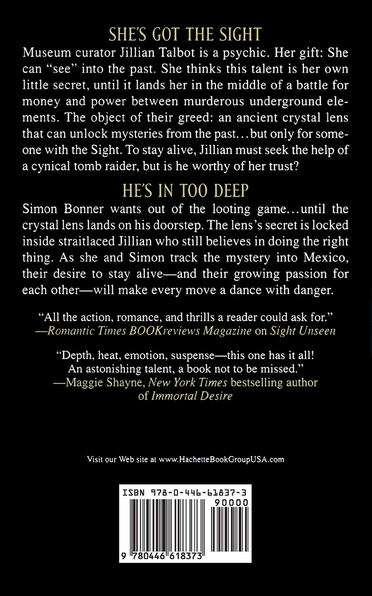
Out of Time back cover.
Hang on, what does that say? Computer, enhance.

Hahaha wait really? This is the author’s seventh book. They couldn’t get anyone to write a sentence about how great it is? No one at all? Harsh.
Moving on I found three reviews, the only three reviews that have been written apparently. I checked Amazon, Book Depository, Barnes & Noble, and a few other places I could find it and these are the only three professional reviews I saw.
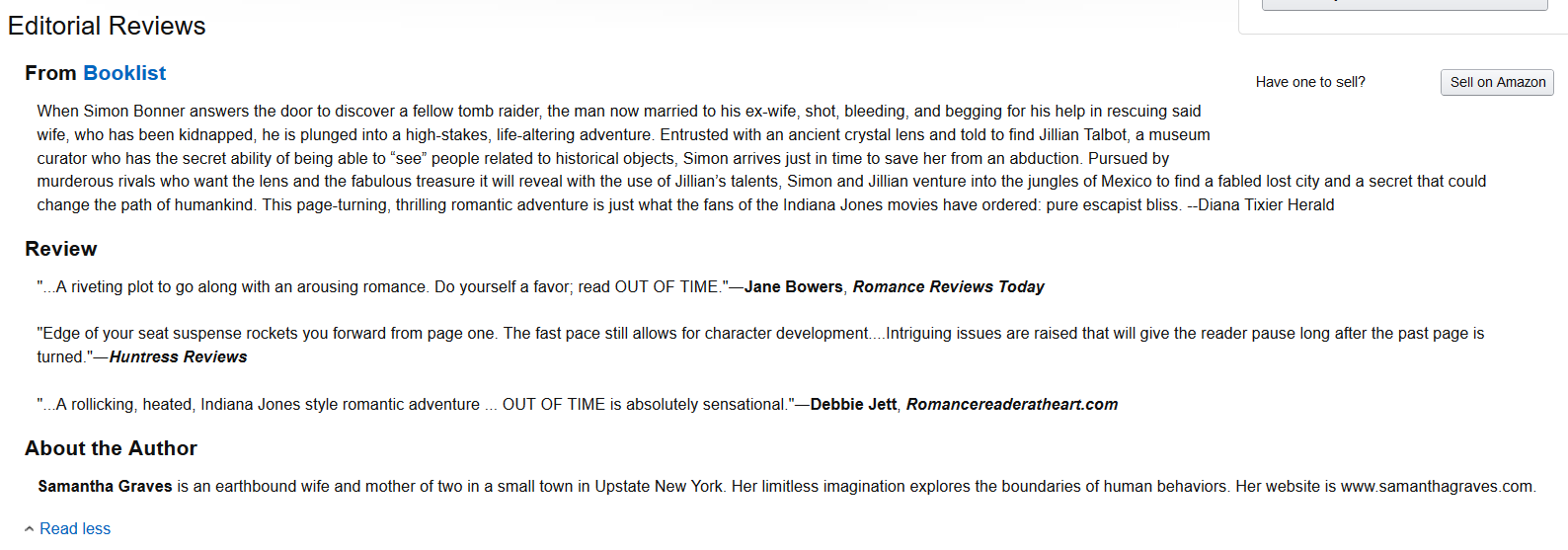
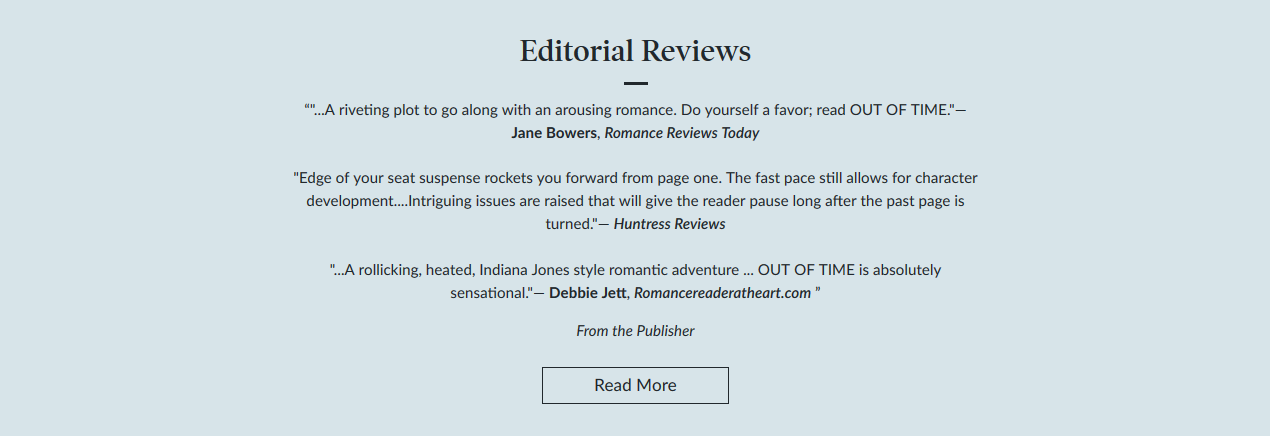
Screenshots from Amazon and Barnes & Noble
These are only excerpts of course, so I went looking for the full reviews, wanting to know everything that others had to say about it. I found very little. I couldn’t find the romancereaderatheart.com review, or even the site itself. I found a blogspot with that name but there were no results when I tried to search the book title or the author’s names. I did find that the domain is currently for sale if anyone wants it.

What a bargain!
So assuming that the site has simply gone under in the intervening years I searched it up in the Wayback Machine and voila!
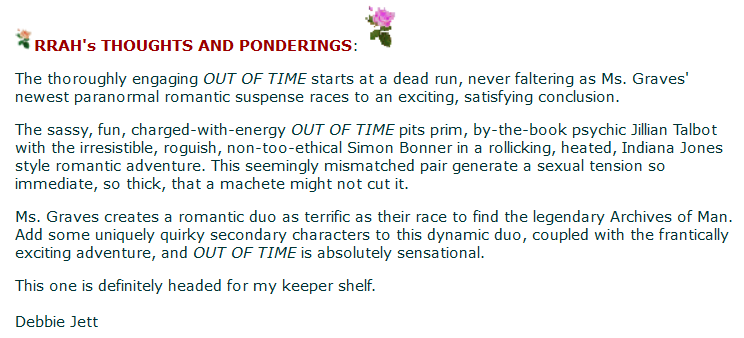
Remember to support the Internet Archive folks.
So she loved it, which I vehemently disagree with, but that’s fine. Some people just get excited very easily I guess. The full review is just more of the unconditional praise the excerpt suggests, without really telling us much about the reviewers feelings about it, just a blurb with more praise. Not particularly useful.
Next is Romance Reviews Today, which I was able to easily find, it’s still around and still updating. The only problem is there’s no sign of this author under either of her names.

We’ve got Graves and we’ve got Barry, just not the one we’re looking for
We’re two for two now on reviews that no longer exist, not a great record. I will assume that the RRT review did exist at some point and isn’t made up, although that may be overly charitable considering our third and final review.
This last review was the easiest to track down, the venerable Huntress Reviews is not only still around it is continuing to post new reviews.
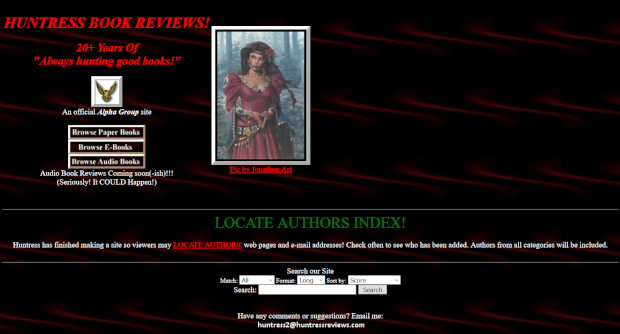
If it ain’t broke don’t fix it.
I had to Ctrl+F my way to the review, but I managed to find it.

No caption can express my disappointment.
So it turns out this review is a retelling of the blurb and then a whole four sentences. I came here looking for the full review only to find that the excerpt was the full review, with one small omission. Spot the difference.


Store page versus original.


See that ellipsis?
Someone, whether Graves, her agent, her editor, or someone at her publisher, omitted the sentence and a half of criticism. It bothers me mostly because the omitted part comprises fully half of the review. The remaining half is then presented on store pages across the internet where it looks like part of a much longer piece. That someone would polish reviews a little I’m not surprised by, what gets me is how brazen it is, and it puts me in an even less generous mood than this book already does.
I did learn one key thing though, which is that book seems to be as forgettable as it appears. Sure some people read it and liked it, but I don’t think many of them remembered it afterwards. And that’s probably intentional. This is a romance novel, and they like to be safe, the same tropes played out over and over. Something you can pick up in an airport, be vaguely entertained by while waiting for your plane, and then never think about again. There’s nothing wrong with wanting some literary oatmeal, but as someone who writes it seems a hollow goal for an author to set out to be forgotten. I can’t say for certain that’s what Samatha Graves wanted, but it’s my most generous interpretation of the end product.
As for whose fault this book is? Well we could blame the notoriously troubled RWA, of which Graves is a member, for stifling the voices being spoken for here. We could blame the audiences that read this and find nothing wrong with it. We could blame society as a whole, we could blame her editor and beta readers, we could blame her publisher.
But when it comes down to it, Samatha Graves/C.J. Barry wrote the book, and it’s her I choose to hold responsible for the offensive and uninspired words within.
0/10 Would not recommend.